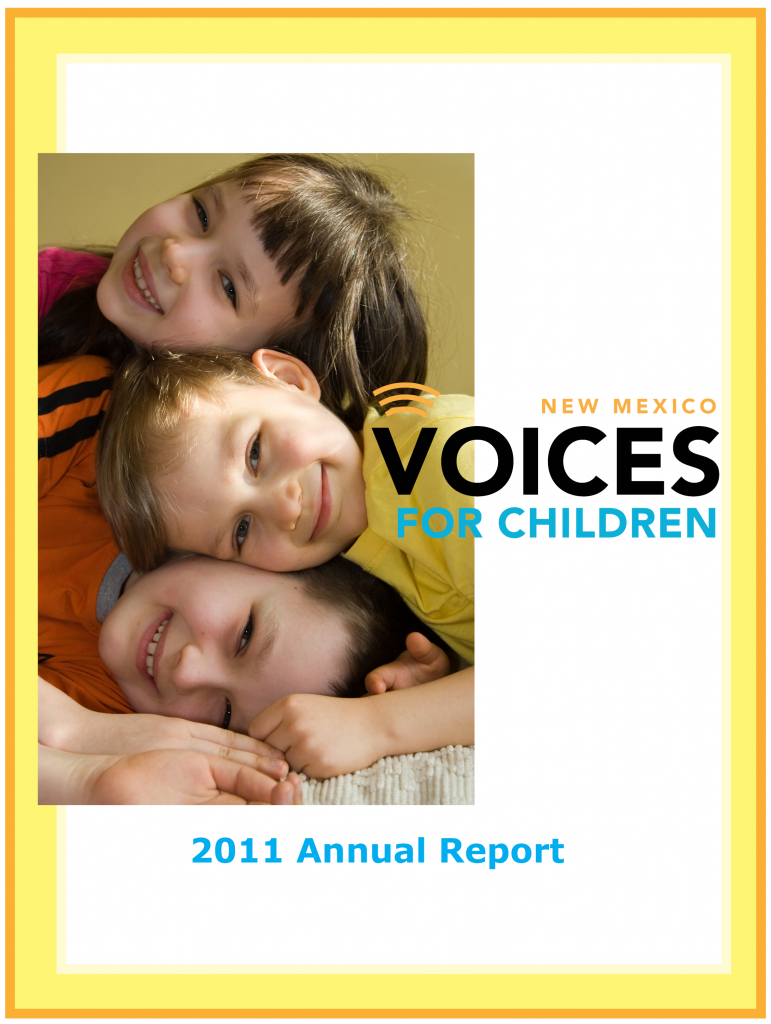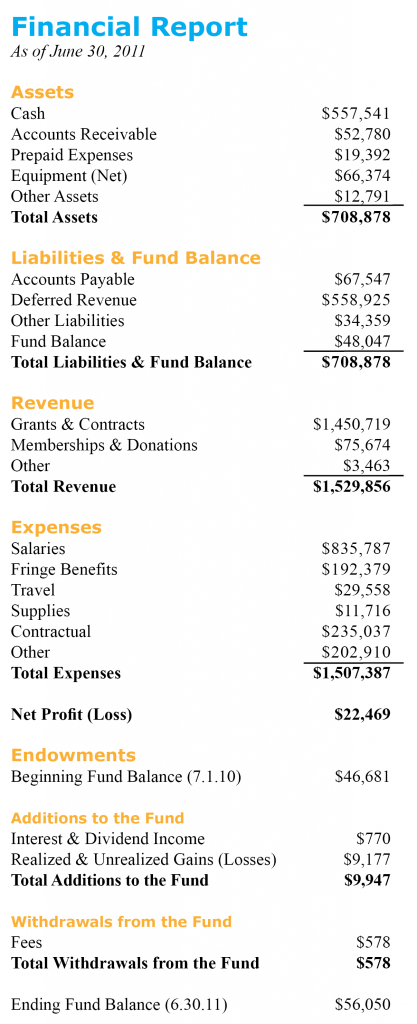Download the full report (April 2012; 12 pages; pdf)
 The Year in Review
The Year in Review
Early Childhood and Education
During our 2011 fiscal year (July 1, 2010 through June 30, 2011) we stepped up our work to secure more funding for early childhood care and education programs. We believe the educational and economic outcome of New Mexico’s children and families would vastly improve if the state were to fund a universally available continuum of programs aimed at children aged zero to five. Such programs, which include parental involvement, high-quality child care, and pre-kindergarten, have been proven to prepare children for greater success in school and later in life. New Mexico has these programs, but they are so poorly funded that only a tiny percent of children benefit from them.
As we looked at potential funding sources for early learning, we determined that the most stable, long-term source would be the state’s Land Grant Permanent Fund. The Fund was set up by Congress just prior to New Mexico gaining statehood in order to fund public education. Its income is derived from earnings in the stock market and royalties from gas and oil extraction. Every year, a small amount (less than 6 percent) of the total Fund is distributed to the various beneficiaries—with the lion’s share going to public K-12 education. As the annual distribution is lower than the income (which averages over 10 percent), the Fund has enjoyed robust growth over the years. It is now the second largest such fund in the nation, at over $10 billion. We researched how the Fund would perform with an additional distribution of 1.5 percent. We determined that the Fund would continue to grow, even doubling over the next 20 years.
In the summer of 2010, we were contracted by Viewpoint Learning, Inc., to assist in community dialogs held in five New Mexico cities. Dialog participants spent one full day learning about the value of early care and education, then discussed how they would like the state or their communities to address the gaps in services for young children. The Land Grant Permanent Fund was presented as a possible funding source. Overwhelmingly, participants were surprised to learn that the state spends less than 2 percent of its general fund budget on all early childhood care and education programs combined. They also felt that the state could not continue to do so little for its youngest residents—that, essentially, doing nothing was not an option.
In October 2010 we co-hosted a policy roundtable on early childhood care and education, Building the Foundation: Birth Through Third Grade, with the New Mexico Association for the Education of Young Children (NMAEYC) and the New Mexico Community Foundation. Sponsored by the Birth to Five Policy Alliance, the roundtable brought together about 50 stakeholders—leaders from the business and labor communities, former and current legislators, education providers, and more—to hear three national speakers talk about early childhood care and education programs and successes elsewhere, and then to discuss possible next steps for New Mexico. The roundtable was followed by meetings to work on strategies for moving forward.
In December 2010 we hosted the statewide 2-day Transforming Education: From Birth to Success convening, which was sponsored by the Annie E. Casey Foundation’s KIDS COUNT program and the WK Kellogg Foundation. About 100 participants heard from national speakers, including Viewpoint Learning, Inc., which did a presentation on results from the public dialogues they had held over the summer. Participants also broke up into smaller workgroups to discuss the feasibility of adapting national models to New Mexico.
We were also able to expand our work on access to health care when we received a grant from the David and Lucile Packard Foundation in February 2011. The grant supports our work to advocate for increased enrollment of eligible children in the state’s Medicaid and CHIP programs (jointly known as New MexiKids) and to streamline the enrollment process.
In January 2011, Governor Susana Martinez took office. The new administration, unfortunately, began almost immediately to decry Medicaid publicly as being “unsustainable.” In order to keep costs of the program down, Governor Martinez hired a consultant to ‘substantially redesign’ the Medicaid program. This required a shift in our policy focus from enrolling more kids to keeping the program from deep cuts. To that end, we updated our report showing that federal Medicaid dollars create jobs and economic activity. We also created and released a new report detailing how the federal health care reform act would benefit the state economically.
Legislative Efforts
The 2011 legislative session took place under the new Governor, who had pledged not to raise taxes, and in an environment with an ongoing shortfall of revenue. We continued to lead the Better Choices New Mexico coalition, which urged lawmakers to take a balanced approach to the budget situation—to raise some taxes rather than relying solely on budget cuts. While we kept the issues of the need for more revenue, a fairer tax system, and the harm done by further budget cuts in the public eye, our efforts were ultimately unsuccessful and the state budget—for the third year in a row—ended up with deep cuts again. We were successful in advocating for an increase in Medicaid funding and we worked in coalition with others to pass legislation to create New Mexico’s Health Insurance Exchange as mandated by federal health care reform, but the bill was vetoed by the governor.
We continued our work on early care and education during the 2011 session by co-launching the Invest in Kids NOW! campaign. Invest in Kids NOW!, jointly led by St. Joseph Community Health and NM Voices, is supported by 34 organizations, ranging from faith-based, labor and business organizations, to early childhood and K-12 educators. The primary objective was to push for a ballot question that would allow voters to amend the state constitution to fund early learning programs out of the Land Grant Permanent Fund. The resolution passed its first two committee hearings but was stalled in the Senate Finance Committee until time ran out on the session. We were successful in raising the visibility of the issue within the news media and public debate.
Reports and Publications
We released four reports as part of our Fiscal Policy Project. New Mexico Revenues and Expenditures: A Mid-Recession Snapshot looked at how the state was recovering—and was expected to continue to recover—from the Great Recession. We updated our Medicaid: An Integral Part of New Mexico’s Economy, which shows how much of an economic stimulus is created in New Mexico by the billions in federal matching money that the state receives for the health care program. We released Race, Ethnicity, and Economic Outcomes in New Mexico, which looked at how racial and ethnic minority groups in New Mexico were faring by various economic indicators. In June 2011, we released The Economic Benefits of Health Care Reform in New Mexico. Similar to our Medicaid report, this one assessed how much New Mexico’s economy will benefit from the influx of federal dollars that will come with the Medicaid expansion in 2014, as well as other ways the landmark legislation will boost the state’s bottom line.
In September 2010, we released Bolstering the Basics: Helping New Mexico Families Work Their Way Out of Poverty, a report funded by the Working Poor Families Project on the status of post-secondary education. We also updated our New Mexico Citizen’s Guide to Children’s Issues in advance of the 2010 elections.
For the Building the Foundation: Birth Through Third Grade policy roundtable, we updated our report Paying for Public Schools in New Mexico, and created the report A Portrait of New Mexico’s Current Investment in Young Children. For the Transforming Education: From Birth to Success convening, we created the fact sheet Potential Revenue Generators and the report New Mexico’s Land Grant Permanent Fund: A Primer, and updated our reports, Property Taxes and Funding Public Schools and Early Childhood Supports in New Mexico: Challenges and Opportunities.
In December 2010 we released a special New Mexico KIDS COUNT report, Disparities Among New Mexico’s Children. It looked at several indicators of child well-being and family economic security, broken down by race and ethnicity. We released our New Mexico KIDS COUNT report in January 2011 to coincide with the opening of the legislative session. This report highlighted the need for greater public investment in early childhood care and education programs in order in improve fourth grade reading scores, high school graduation rates, and other educational outcomes.
Special Events
We held our second Spirit of Hope Celebration in September of 2010, where we honored the community service work of New Mexicans by bestowing the Alice King Public Service Award, Patty Jennings Citizen Advocacy Award, and the 17th Annual Amy Biehl Youth Spirit Award. McClellan Hall of Gallup—who created the National Indian Youth Leadership Project, which provides substance abuse prevention, leadership development, and service learning opportunities for Native Youth—won the Second Annual Alice King Public Service Award. Tara Ford of Albuquerque— who is co-director of Pegasus Legal Services for Children, which provides legal services for kids in the foster care system—won the Patty Jennings Citizen Advocacy Award. The first place honorees for the Amy Biehl Youth Spirit Award were D’Ana Alderete and Cecilia Frescas, both of Albuquerque. The second place honorees were Jacqueline Gibbs of Santa Fe and Denise Chavez of Albuquerque. We also paid tribute to long-time NM Voices Board member Polly Arango, who had died suddenly earlier that summer.
Download the full report (April 2012; 12 pages; pdf)


